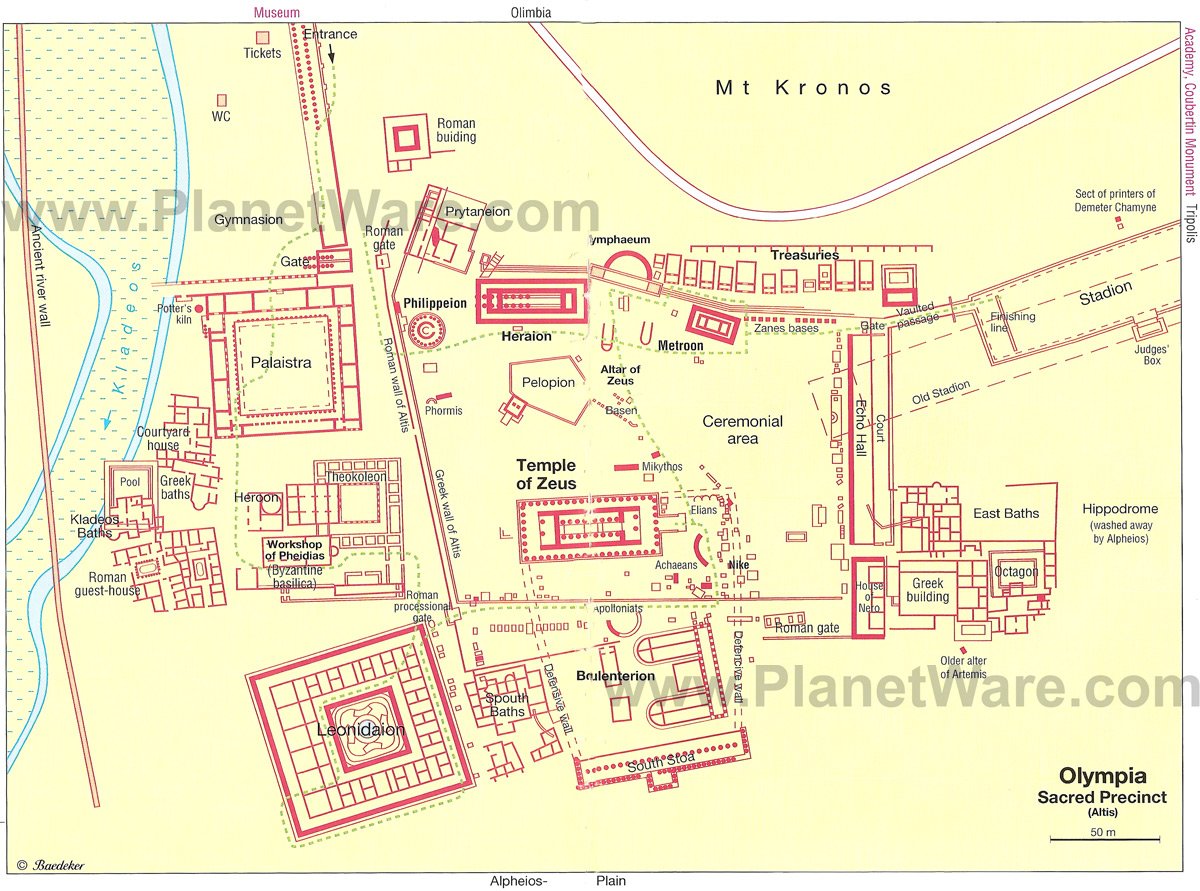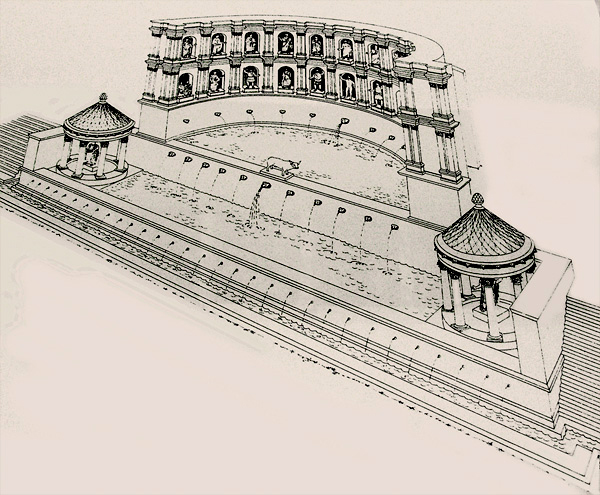 Olympia Archaeological Site
Olympia Archaeological SiteSituated at the foot of Mount Chronos, Olympia was the birthplace of the Olympic Games.
An artist's rending of ancient Olympia (Right).
Clearly visible in the background is Mount Chronos. The large building in the foreground is the Temple of Zeus, which housed one of the Seven Wonders of the Ancient World - The Statue of Zeus. The statue, made out of gold, ivory, and precious jewels, stood 43-ft high (that's 13 metres in metric. About four stories high!!) The artist, Phidias, also made the famous frieze of the Parthenon in Athens.
Unfortunately, very little of Olympia survived the ravages of time.
Site Map of Olympia
(Courtesy of PlanetWare.com)

This would be where the athletes trained (wearing nothing but their birthday suits, no less.) As you can see, nothing remains of this building save for a few column stumps to mark the foundation.
Temple of Zeus (???)
More ruins... I cannot, for the life of me, identify the structures in the photo below. The trees blocking the sight of view certainly do not make things any easier. The ruins start to look the same after a while. While I wish more restoration could be done so we can have a better idea of what Olympia was truly like in its prime, it is almost impossible due to the state of the stones. Maybe one day, when 3D-hologram technology become more advanced... It would be unbelievably cool, just to be able to walk inside the Temple of Zeus and see the famous statue, even if it's all hologram.




Philippeion
One of the few structures onsite that retained enough of its features as to give us a glimpse of its former self.
Dedicated to Philip, King of Macedonia and the father of Alexander the Great (whose image has been forever tarnished by Colin Farrel), this once-circular structure was decorated in gold and ivory. It is the only structure in Altis (the sacred ground of Olympia) dedicated to a non-deity.


 Here is one of the artifacts (likely to be a foundation or column stone), covered with mollusks and other shelled critters. This gave credence to the hypothesis that Olympia was once under ocean water due to earthquake-induced tsunamis. Pretty incredulous considering the fact that Olympia is situated more than 10 km inland.
Here is one of the artifacts (likely to be a foundation or column stone), covered with mollusks and other shelled critters. This gave credence to the hypothesis that Olympia was once under ocean water due to earthquake-induced tsunamis. Pretty incredulous considering the fact that Olympia is situated more than 10 km inland. Nike of Paionios
Nike of PaioniosThis is the pedestal column upon which the statue of Nike, goddess of Victory, would have stood. The statue is currently in the Olympia museum, which we visited afterwards. The pedestal was likely to have been painted blue so as to give the optical illusion of the winged goddess flying/floating in mid-air.
More Temple of Zeus (?)
 Nymphaeum of Herodes Atticus
Nymphaeum of Herodes AtticusBased on the artist's rendering, it was a gorgeous fountain dedicated to the Nymphs that channeled spring water to the rest of the Altis.
Herodes Atticus was the wealthy benefactor who funded the construction of the fountain. Judging by the fact that his full name was Lucius Vibullius Hipparchus Tiberius Claudius Atticus Herodes (try saying that three times fast!) and that he has his own wiki entry 2000 years later, Herodes here must have been one rich and powerful dude!
 My photo only captured a very small part of the fountain (that's the Temple of Hera on the left.) Only parts of the naiskos (the pagoda-looking structures) on either side of the fountain remain.
My photo only captured a very small part of the fountain (that's the Temple of Hera on the left.) Only parts of the naiskos (the pagoda-looking structures) on either side of the fountain remain.
Temple of Hera
Although much smaller than her husband's, Hera's temple is in much better shape. It also receives more press coverage as this is where the ceremonial Olympic flame is lit every four years. According to our guide, the flame is lit using only the sun and a parabolic mirror (Hmm... I wonder if that's really the case. How long does it take to light a torch with just the sun and a mirror? Maybe there's a hidden lighter inside the torch we don't know about...)

 The Stadium - Entrance from the Altis
The Stadium - Entrance from the AltisThis is my favourite part of the archaeological site. The stadium, though plain-looking, is the only area that still retains the competitive spirit of the Olympic Games. Walking along the path and through the arched gateway to the stadium, you get a sense of what the ancient athletes must have felt. To stand there at the doorway, adrenaline pumping, waving to thousands of adoring fans all screaming your name, readying for the race ahead. Years of training and victory was just a couple hundred of metres within reach.
The original marble starting line (Left). Unbelievably cool. The Judges' Box (Right).


There were simply too many people in the way to run the entire track. However, just walking the dirt track was satisfying enough.
 Olympia Archaeological Museum
Olympia Archaeological MuseumLook at the size of the marble torso. It is almost as tall as me. The complete statue must be over 10 feet. It still amazes me that the ancient Greeks had the skills to make these marvelous sculptures and buildings over two thousand years ago, back when the rest of Europe was still struggling and was considered barbaric. Who knows what kinds of amazing advances would have been made by now if the Roman Empire didn't collapse and the Dark Ages never occurred? Humans are really our own worst enemy.
Model of Ancient Olympia. In the centre - The Temple of Zeus; above - The Temple of Hera; upper left - Palaestra/Gymnasium. You can even see the Nymphaeum fountain just off to the side of the Temple of Hera.
The Frieze from the Temple of Zeus.


 Neat trivia: to save resources, ancient Romans would use detachable heads on their sculptures. So if an emperor/general/famous person dies/falls out of favour, they can just lop the head off and pop on the head of another.
Neat trivia: to save resources, ancient Romans would use detachable heads on their sculptures. So if an emperor/general/famous person dies/falls out of favour, they can just lop the head off and pop on the head of another. Now that's what I call Reduce, Reuse, Recycle.
We meet at last, Winged Goddess of Victory. You may have lost your face and your wings over the years, but you still look marvelous. And with Nike behind us, we bid a fond farewell to Olympia (and proceeded to visit the souvenir shops two blocks over.)

Katakolon
A very small coastal town. There wasn't much to do except stroll through the souvenir shop-packed street. I managed to find a small convenience shop to buy some postage stamps (the postal office was closed.) I tried to find the BiC pencils that have Greek lettering someone had once told me about but no such luck. And since I couldn't possible bring back the giant tins of olive oil, I left the store relatively empty-handed. It was nice to just busk under the Grecian sun for a while (wearing SPF50 sunblock of course, I'm not insane).









No comments:
Post a Comment